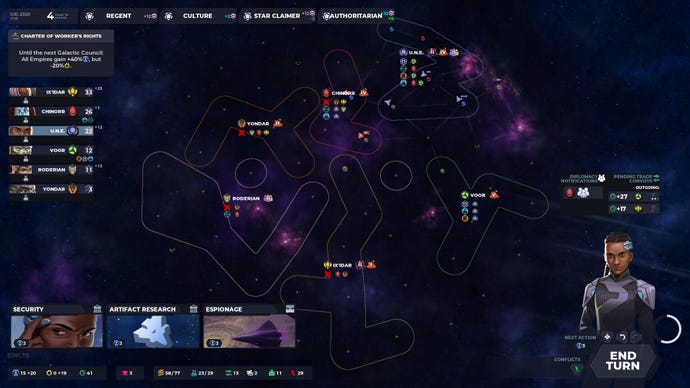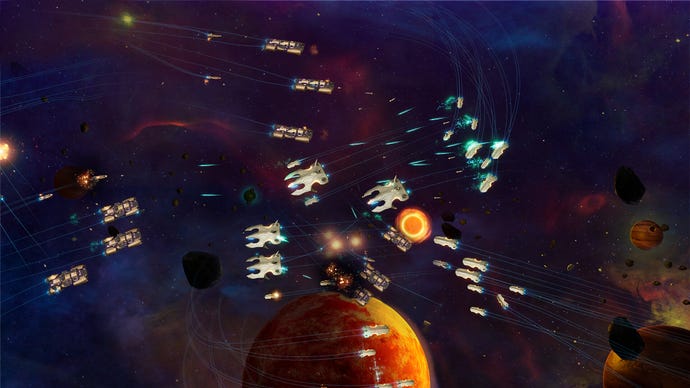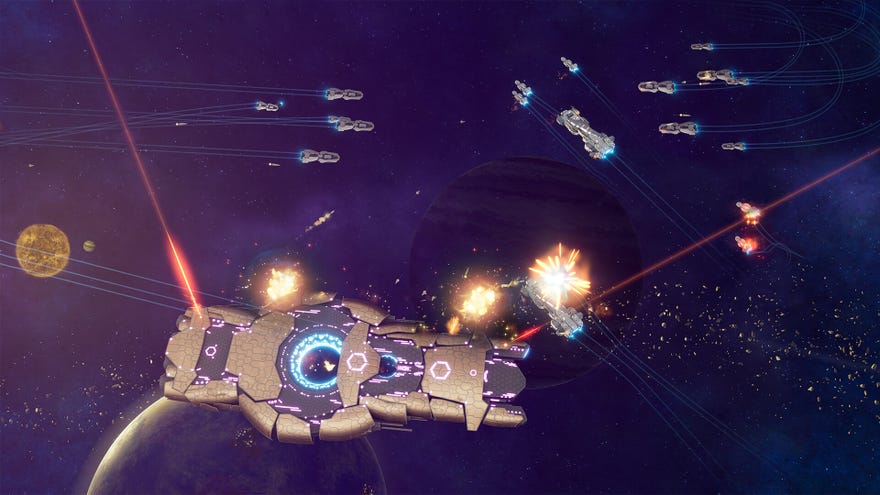Stellaris Nexus shrinks and speeds up Stellaris to mostly exhilarating effect
The fourth X is for aXeleration, actually
Rome wasn't built in a day, but in sci-fi strategy game Stellaris Nexus, you can found, expand and fritter away a whole intergalactic empire in around an hour. In the case of my multiplayer hands-on, that empire was the Ix'Idar, a race of burrowing insect critters with a unique resource - pheromones. Boldly disregarding the PR's gentle advice that I start with an easier-to-master race, I set out to swarm the galaxy and immediately found myself at the bottom of the victory or "Succession" point scoreboard, with one player picking off my planets by means of espionage, while others stomped my fleets of stargrubs flat in no-nonsense space combat.
I did manage to briefly take possession of the titular Nexus, a throneworld which awards beaucoup Succession points to its owner, but it turns out fixating on the Nexus is a great way to set yourself up for a midgame dogpile - you pour resources into capturing it, sacrifice half your fleet to the first invader, then lose it all to the second. With my initially bountiful dominions rudely shrunk to a smattering of isolated planets, I took the coward's way out of the press event and said I had to be going because I had other work to attend to. I didn't at all! I just wanted to go and cry in the toilet. Alas for the Ix'Idar - not so much "lions led by donkeys" as an antfarm in the hands of a wilful toddler.

This is all coming out in a rush. But hey, that's Stellaris Nexus - a 4X game on fast-forward, which takes the structure, narrative stylings and key mechanics of older sister Stellaris and tries to cram it all into the average lunchbreak. Is it a success? I'm a little undecided, but I'm enjoying how the game's act of shrinkification throws the genre's core workings into sharper relief.
The usual broad 4X playstyles are present and correct: you can win by means of military expansion, focus on research to gain a qualitative advantage, use diplomacy and espionage to wrongfoot opponents, or pull ahead by means of cultural supremacy. There's also a seasonal galactic council mechanic, in which players can award each other titles and vote on galaxy-wide modifiers or bonuses, like increased planetary population growth at the expense of manufacturing output.
As you'd expect, each approach to winning is strengthened or weakened by choice of faction, in little and large ways: the snooty Voor, for example, get a unique resource called Patrons which allows them to fund "academic" fleets in any visible solar system, for speedy early-game reconnaissance. But everything is so much nippier, with many smaller 4X mechanics stripped down, rearranged or removed entirely, and play now broken into turns that unfold simultaneously once you've made all your choices. Turns also have time limits, though each player is granted a limited reservoir of overtime for those trickier decisions.

If the turn time limit is the blunter means of accelerating the 4Xing, the clever bit, for me, is how the game streamlines what happens inside each turn. It borrows tricks from cardgames while placing the emphasis on one particular resource, Support, which functions a bit like Action Points in turn-based CRPGs. Broader actions such as researching a tech, sending out a scoutship, or building a planetary structure take the form of cards, drawn semi-randomly each turn. The unpredictability can be irritating, of course, but the benefit is that you spend less time mulling your approach, because the options are constrained in advance - though there's a Politics card you can discard to draw another of your choosing.
Each of these broad actions cost Support points, and each successive action costs more, which imposes a soft cap on what you can do in each turn, and gets you into the habit of pinning down priorities. You earn Support points each turn, but you'll earn fewer of them for every planet you conquer, which convincingly models the bureaucratic unwieldiness of larger empires, while encouraging you to expand warily, even if the other players aren't putting up much resistance.
Beyond Support, the game offers up a familiar spread of 4X resources, including Research points earned from universities and the like, Materials from factories for building and spaceship construction, and Credits that serve as a wildcard, letting you buy stuff rather than spending Materials or Support.

And then there's combat, which resolves automatically once you drop opposing fleets into the same system. It's been boiled right back to rock-paper-scissors, with Raider ships good against Carriers, while Carriers have the edge against Capital Ships, and Capital Ships are great at squishing Raiders. Carriers can also send fighters to harry targets from neighbouring systems, allowing you to soften foes up without indulging in any attrition, while offensive-minded Raiders can jump two systems in one turn. You can modify this interplay by researching certain techs, picking certain races and so forth, but the triangular power relationship persists throughout, and again, the payoff is quicker decision-making. Much of the time, deciding whether to attack is a question of ensuring that you're putting the right ships together, and that your fleet has more hitpoints.
Despite my shambolic performance, I very much enjoyed my time with Stellaris Nexus. But I do have a few criticisms and anxieties, all rather predictable. Firstly, how much of the fun will depend on playing against filthy back-stabbing humans? I've only dipped a toe into the campaign portion of the press build, playing through a couple of solo missions, but the AI doesn't seem very wily, relying on constrained scenarios to create intrigue. Secondly, will this deliberately caffeinated 4X really lend itself to more elaborate winning strategies, the kinds of alchemical mixing of very specific race traits and techs that allow great players to pull victory from the hat, as if by magic? It's hard to get a sense of that in one hour, especially when you've made it your business to turn everybody into larva fodder.

Lastly, and for all the relative snappiness of the presentation, the claim that you can play a round of Nexus in under an hour hinges on every player having a solid, existing grasp of the rules. The UI does a reasonable job of digesting everything - you can zoom out from planets to view them as a cluster of icons and building slots - but you'll definitely need to play a few rounds before the broad strokes become second nature. Jump into a random online game without chugging through the tutorials, and you're likely to feel overwhelmed. I, for instance, still have no idea what the Ix'Idar do with their precious pheromones, though I only have my brainless expansionist tendencies to blame for that.
As pick-up-and-play friendly as the game's visual language can be, there's a fair wodge of sci-fi terminology to chew through in descriptions for technologies and so forth. At its most overwrought, it feels like Nexus would work better if it weren't a Stellaris game, and were able to communicate itself in a more abstract, less worldbuildy way. The parent franchise brings with it an expectation of lore that trips the game up, and threatens to mire it between genres. Still, the proof there will very much be in the 4X pudding, and I'm looking forward to my next plateful.









